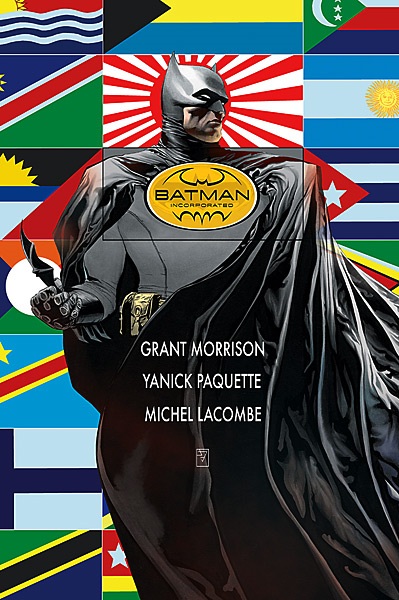Images & Words – Batman Incorporated #1

[images & words is the comic book pick-of-the-week at OL. equal parts review and diatribe, the post highlights the most memorable/infuriating/entertaining book released that wednesday]
Why is Batman successful? Is it because of a physique that pushes the limits of the human anatomy, an absolute mastery of sensory perception, an above-genius IQ, and billions of dollars? Yes.
And no.
In the internal logic of the comics-world, Batman truly succeeds not as a man but as an idea. More important than a single super-stud willing to risk his life in the name of crime-fighting is the very notion that such individuals exist. Criminals and evil-doers simply cannot run amok; doing so generates the very real possibility of being put in traction by a masked vigilante with emotional issues.
For the past seventy-one years, Batman has protected Gotham City. Now, the persona is being franchised globally as this week sees the premiere of Batman Incorporated.
In case you’re not up to speed: Bruce Wayne died, Dick Grayson took over as Batman, Damian Wayne became Robin, Bruce Wayne returned and decided that having two Batmans (or is it Batmen?) wasn’t a bad idea. In fact, he decided that it was such a good idea that he is now going to travel over the world, training worthy citizens to become the vigilante-sentries of their respective countries. In other-words, Batman is no longer an American myth, but a universal archetype.
Multinational personae importante.
Of course, this concept is hardly foreign terrain to scribe/myth-maker/truth-revealer Grant Morrison. In Batman #667-669, Morrison revived the Batmen of All Nations. Rebranded as the Club of Heroes, this team of international Batman analogs were steered through three of the best Batman issues of recent history. Brought to life by the mighty JH Williams III, each member of the Club embodied the spirit of the caped crusader while still maintaining qualities unique to their homeland. As a result, the reader couldn’t help but head-scratch and wonder, “Yeah, what if…?”
With Batman Incorporated, Morrison is putting the development of Bat-people into the hands of Bruce Wayne. The first issue sees Wayne traveling to Japan (with Selina Kyle, oh isn’t there a world where they could just make it official?!) to train local hero Mr. Unknown as a Batman. Unfortunately, when he rolls up to the Land of the Rising Sun, Mr. Unknown is dead! What this leaves is a murder-mystery for Bruce to solve and the prospect that Unknown’s sidekick will be inducted as Japan-Style Batman!
In addition to setting the story in Japan, Morrison has injected the first issue of Batman Incorporated with plenty of Japanese pop-culture aesthetic. Or, at least what the West perceives as Japan’s pop-culture aesthetic. Yanick Paquette and colorist Michel Lacombe depict Narita as having the type of bustling, neon downtown that serious documentaries have told us are indigenous to Japan. On top of the signage and architecture, we know where our heroes are because of the pastiches they must overcome; for example, Batman and Catwoman battle invisible, robot-monsters.
Yes, it’s kawaii.
But as always, Morrison also adds a layer of hidden depth to his work. The choice of villain for Batman Incorporated‘s first arc: Lord Death Man. Not familiar with the character? Don’t worry, you’re not alone. In the mid 1960s, Japanese artist Jiro Kuwata created a number of Batman adaptations for his manga-house. Although using U.S. Batman comics as source material, Kuwata’s stories went in drastically different directions. As chronicled in Bat-Manga!, the foes challenging the Dark Knight included pterodactyls and the man who quit being human.
Ah, but back to Lord Death Man! This character is a Kuwata-adaption of Death-Man, a villain who made a single appearance in Batman vol. 1 #180. So Morrison is essentially reimagining a Japanese-reimagining of an obscure character, placing him in a storyline about reimagining the Batman-mythos as a whole.
Holy shit, that’s heavy.
Esoteric comics-knowledge aside, Batman Incorporated is a legitimate book. Morrison and his team of narrative-bandits are filching elements from various sources, throwing them into a nuclear-powered story machine, and producing something novel.
Dangerous to the status quo? Yes.
Dangerous to your mind? Hell no.



